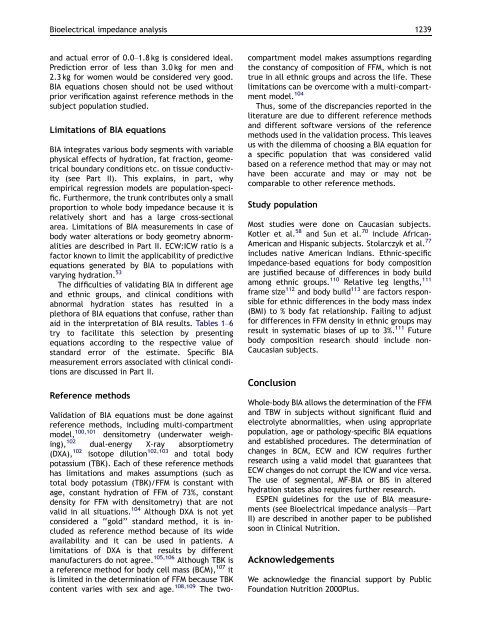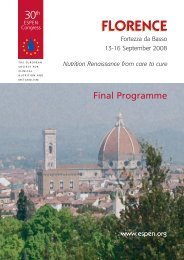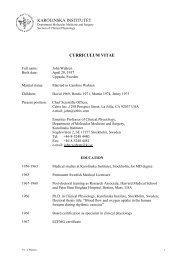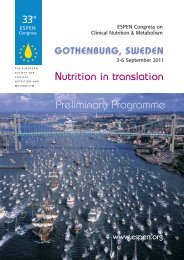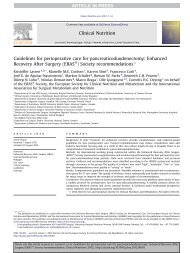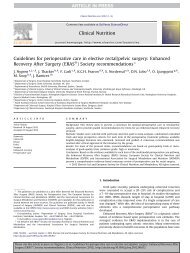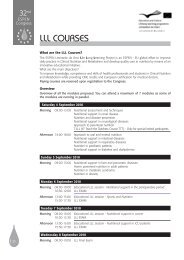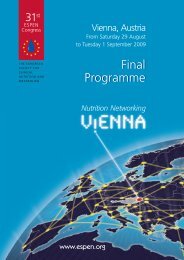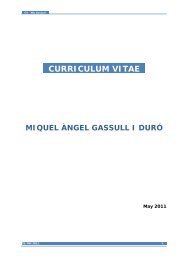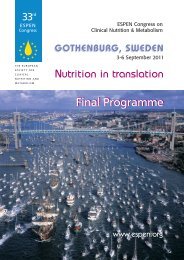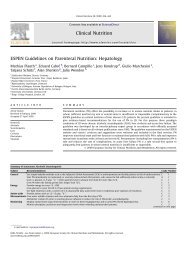Bioelectrical impedance analysisFpart I: review of principles ... - espen
Bioelectrical impedance analysisFpart I: review of principles ... - espen
Bioelectrical impedance analysisFpart I: review of principles ... - espen
Create successful ePaper yourself
Turn your PDF publications into a flip-book with our unique Google optimized e-Paper software.
and actual error <strong>of</strong> 0.0–1.8 kg is considered ideal.<br />
Prediction error <strong>of</strong> less than 3.0 kg for men and<br />
2.3 kg for women would be considered very good.<br />
BIA equations chosen should not be used without<br />
prior verification against reference methods in the<br />
subject population studied.<br />
Limitations <strong>of</strong> BIA equations<br />
BIA integrates various body segments with variable<br />
physical effects <strong>of</strong> hydration, fat fraction, geometrical<br />
boundary conditions etc. on tissue conductivity<br />
(see Part II). This explains, in part, why<br />
empirical regression models are population-specific.<br />
Furthermore, the trunk contributes only a small<br />
proportion to whole body <strong>impedance</strong> because it is<br />
relatively short and has a large cross-sectional<br />
area. Limitations <strong>of</strong> BIA measurements in case <strong>of</strong><br />
body water alterations or body geometry abnormalities<br />
are described in Part II. ECW:ICW ratio is a<br />
factor known to limit the applicability <strong>of</strong> predictive<br />
equations generated by BIA to populations with<br />
varying hydration. 53<br />
The difficulties <strong>of</strong> validating BIA in different age<br />
and ethnic groups, and clinical conditions with<br />
abnormal hydration states has resulted in a<br />
plethora <strong>of</strong> BIA equations that confuse, rather than<br />
aid in the interpretation <strong>of</strong> BIA results. Tables 1–6<br />
try to facilitate this selection by presenting<br />
equations according to the respective value <strong>of</strong><br />
standard error <strong>of</strong> the estimate. Specific BIA<br />
measurement errors associated with clinical conditions<br />
are discussed in Part II.<br />
Reference methods<br />
Validation <strong>of</strong> BIA equations must be done against<br />
reference methods, including multi-compartment<br />
model, 100,101 densitometry (underwater weigh-<br />
ing), 102<br />
dual-energy X-ray absorptiometry<br />
(DXA), 102 isotope dilution 102,103 and total body<br />
potassium (TBK). Each <strong>of</strong> these reference methods<br />
has limitations and makes assumptions (such as<br />
total body potassium (TBK)/FFM is constant with<br />
age, constant hydration <strong>of</strong> FFM <strong>of</strong> 73%, constant<br />
density for FFM with densitometry) that are not<br />
valid in all situations. 104 Although DXA is not yet<br />
considered a ‘‘gold’’ standard method, it is included<br />
as reference method because <strong>of</strong> its wide<br />
availability and it can be used in patients. A<br />
limitations <strong>of</strong> DXA is that results by different<br />
manufacturers do not agree. 105,106 Although TBK is<br />
a reference method for body cell mass (BCM), 107 it<br />
is limited in the determination <strong>of</strong> FFM because TBK<br />
content varies with sex and age. 108,109 The two-<br />
ARTICLE IN PRESS<br />
<strong>Bioelectrical</strong> <strong>impedance</strong> analysis 1239<br />
compartment model makes assumptions regarding<br />
the constancy <strong>of</strong> composition <strong>of</strong> FFM, which is not<br />
true in all ethnic groups and across the life. These<br />
limitations can be overcome with a multi-compartment<br />
model. 104<br />
Thus, some <strong>of</strong> the discrepancies reported in the<br />
literature are due to different reference methods<br />
and different s<strong>of</strong>tware versions <strong>of</strong> the reference<br />
methods used in the validation process. This leaves<br />
us with the dilemma <strong>of</strong> choosing a BIA equation for<br />
a specific population that was considered valid<br />
based on a reference method that may or may not<br />
have been accurate and may or may not be<br />
comparable to other reference methods.<br />
Study population<br />
Most studies were done on Caucasian subjects.<br />
Kotler et al. 58 and Sun et al. 70 include African-<br />
American and Hispanic subjects. Stolarczyk et al. 77<br />
includes native American Indians. Ethnic-specific<br />
<strong>impedance</strong>-based equations for body composition<br />
are justified because <strong>of</strong> differences in body build<br />
among ethnic groups. 110 Relative leg lengths, 111<br />
frame size 112 and body build 113 are factors responsible<br />
for ethnic differences in the body mass index<br />
(BMI) to % body fat relationship. Failing to adjust<br />
for differences in FFM density in ethnic groups may<br />
result in systematic biases <strong>of</strong> up to 3%. 111 Future<br />
body composition research should include non-<br />
Caucasian subjects.<br />
Conclusion<br />
Whole-body BIA allows the determination <strong>of</strong> the FFM<br />
and TBW in subjects without significant fluid and<br />
electrolyte abnormalities, when using appropriate<br />
population, age or pathology-specific BIA equations<br />
and established procedures. The determination <strong>of</strong><br />
changes in BCM, ECW and ICW requires further<br />
research using a valid model that guarantees that<br />
ECW changes do not corrupt the ICW and vice versa.<br />
The use <strong>of</strong> segmental, MF-BIA or BIS in altered<br />
hydration states also requires further research.<br />
ESPEN guidelines for the use <strong>of</strong> BIA measurements<br />
(see <strong>Bioelectrical</strong> <strong>impedance</strong> analysisFPart<br />
II) are described in another paper to be published<br />
soon in Clinical Nutrition.<br />
Acknowledgements<br />
We acknowledge the financial support by Public<br />
Foundation Nutrition 2000Plus.


